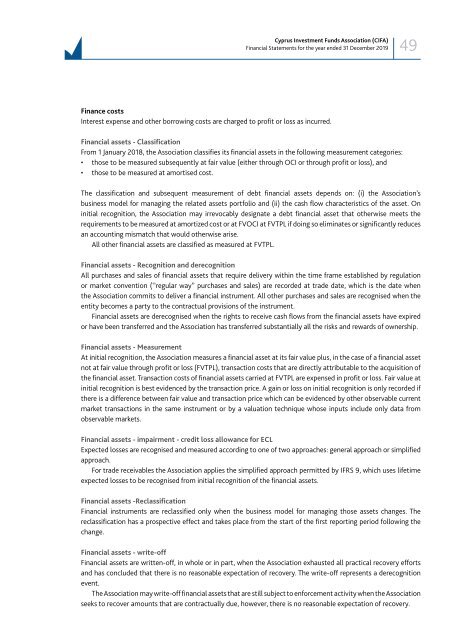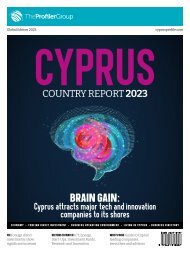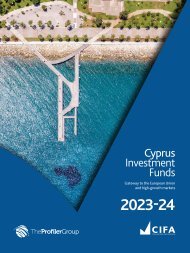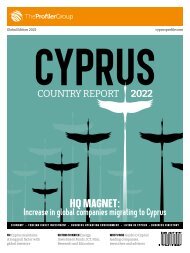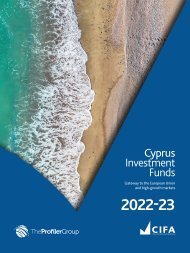CIFA Annual Review 2020
Cyprus Investment Funds Association Annual Review 2020
Cyprus Investment Funds Association Annual Review 2020
You also want an ePaper? Increase the reach of your titles
YUMPU automatically turns print PDFs into web optimized ePapers that Google loves.
Cyprus Investment Funds Association (<strong>CIFA</strong>)<br />
Financial Statements for the year ended 31 December 2019 49<br />
Finance costs<br />
Interest expense and other borrowing costs are charged to profit or loss as incurred.<br />
Financial assets - Classification<br />
From 1 January 2018, the Association classifies its financial assets in the following measurement categories:<br />
• those to be measured subsequently at fair value (either through OCI or through profit or loss), and<br />
• those to be measured at amortised cost.<br />
The classification and subsequent measurement of debt financial assets depends on: (i) the Association’s<br />
business model for managing the related assets portfolio and (ii) the cash flow characteristics of the asset. On<br />
initial recognition, the Association may irrevocably designate a debt financial asset that otherwise meets the<br />
requirements to be measured at amortized cost or at FVOCI at FVTPL if doing so eliminates or significantly reduces<br />
an accounting mismatch that would otherwise arise.<br />
All other financial assets are classified as measured at FVTPL.<br />
Financial assets - Recognition and derecognition<br />
All purchases and sales of financial assets that require delivery within the time frame established by regulation<br />
or market convention (‘’regular way’’ purchases and sales) are recorded at trade date, which is the date when<br />
the Association commits to deliver a financial instrument. All other purchases and sales are recognised when the<br />
entity becomes a party to the contractual provisions of the instrument.<br />
Financial assets are derecognised when the rights to receive cash flows from the financial assets have expired<br />
or have been transferred and the Association has transferred substantially all the risks and rewards of ownership.<br />
Financial assets - Measurement<br />
At initial recognition, the Association measures a financial asset at its fair value plus, in the case of a financial asset<br />
not at fair value through profit or loss (FVTPL), transaction costs that are directly attributable to the acquisition of<br />
the financial asset. Transaction costs of financial assets carried at FVTPL are expensed in profit or loss. Fair value at<br />
initial recognition is best evidenced by the transaction price. A gain or loss on initial recognition is only recorded if<br />
there is a difference between fair value and transaction price which can be evidenced by other observable current<br />
market transactions in the same instrument or by a valuation technique whose inputs include only data from<br />
observable markets.<br />
Financial assets - impairment - credit loss allowance for ECL<br />
Expected losses are recognised and measured according to one of two approaches: general approach or simplified<br />
approach.<br />
For trade receivables the Association applies the simplified approach permitted by IFRS 9, which uses lifetime<br />
expected losses to be recognised from initial recognition of the financial assets.<br />
Financial assets -Reclassification<br />
Financial instruments are reclassified only when the business model for managing those assets changes. The<br />
reclassification has a prospective effect and takes place from the start of the first reporting period following the<br />
change.<br />
Financial assets - write-off<br />
Financial assets are written-off, in whole or in part, when the Association exhausted all practical recovery efforts<br />
and has concluded that there is no reasonable expectation of recovery. The write-off represents a derecognition<br />
event.<br />
The Association may write-off financial assets that are still subject to enforcement activity when the Association<br />
seeks to recover amounts that are contractually due, however, there is no reasonable expectation of recovery.


